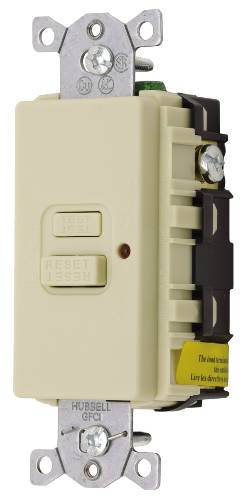

However, there are a couple of exceptions to this rule. GFCI protection devices are also required for all 15A and 20A, 125V receptacles located in garages and grade-level portions of unfinished or finished accessory buildings used for storage or work areas of a dwelling unit. However, 210.8(B)(3) requires all 15A and 20A, 125V receptacles in a commercial kitchen to be GFCI-protected.Īs noted above, GFCI protection has been required for all 15A and 20A, 125V receptacles in the bathroom area of a dwelling unit for more than 20 yr. 210.8(A)(6) for dwelling units only requires GFCI protection for 15A and 20A, 125V receptacles installed to serve dwelling unit kitchen counter surfaces. This new rule sets up an interesting situation.
#Cannot find 15 amp faceless gfci install
The only exception to this rule is that you need not install GFCI protection for fixed electric snow melting or de-icing equipment receptacles that are not readily accessible and are supplied by a dedicated branch circuit in accordance with 426.28.Įvery receptacle installed in kitchens must be GFCI-protected. In addition, 210.63 requires you to install a 15A or 20A, 125V receptacle outlet within 25 ft of heating, air conditioning, and refrigeration equipment. However, GFCI protection is not required for receptacles installed outside a commercial or industrial occupancy. Per 210.8, you must install GFCI protection for all 15A and 20A, 125V receptacles located in bathrooms, rooftops, and kitchens in commercial/industrial facilities.


(For a complete list of 2002 NEC references, see the Sidebar at the end of this article.)
#Cannot find 15 amp faceless gfci code
Initially, it was only required for temporary wiring at construction sites and in dwelling unit bathrooms, but in recent years the Code requirements for GFCI protection have expanded to include many other areas, including commercial occupancies, fountains and swimming pools, and temporary installations, to name a few. Since 1971, the NEC has expanded the requirements for ground-fault circuit interrupters (GFCI) to protect anyone who plugs into an electrical system. Note: This article is based on the 1999 NEC. If you’d like to see updated information on this topic, please check out this recently published article, Recent Rule Changes for GFCI Protection. But it was the GFI outlet that was the culprit.Thank you for visiting one of our most popular classic articles. This one was a little bit fun to solve as I did not directly see the GFI (as it was over the phone).īoth situations they checked the breakers before calling me. It tripped and the second outlet lost power too. The other situation was a storefront had a six splitter mounted on top of a GFI. When the GFI tripped, there was no power in the Master bathroom. One was a GFI in one bathroom powered some outlets in a second bathroom. In the past two weeks I had to troubleshoot two service calls over the phone. When it comes to use, it’s really up to the electrician, Whether he wants to run GFI or GFCI breaker depending on his application. They are about 3-4 times the price of a regular breaker. In many wet locations they have become code about 8 to 10 years ago. I have a GFCI breaker for my hot tub and I have another one that feeds my rotary phase converter.Īt one point in time, I had one on my Tig welder.


 0 kommentar(er)
0 kommentar(er)
